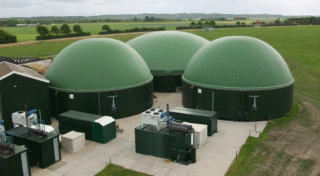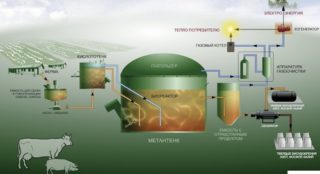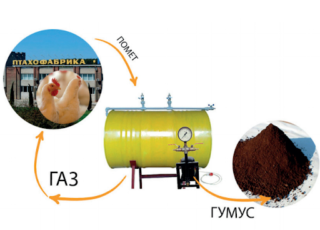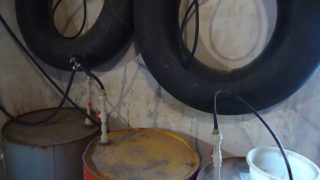Stationary biogas plant is designed for the effective elimination of waste, obtaining raw materials and low-cost energy. You can assemble such equipment with your own hands and use the generated gas for the purpose of heating the room, cooking, and other needs. Before construction, it is useful to learn about the operation principle of the installation, the types of raw materials suitable for it, the specifics of obtaining biological gas, and all stages of installation.
Biogas determination
Biogas of the standard type is a natural fuel produced as a result of the fermentation of biological substrates. It decomposes under the influence of hydrolysis, as well as acid and methane-forming bacterial organisms. The resulting mixture has combustible properties due to the high methane content, due to its characteristics it almost does not differ from the usual natural raw materials used for domestic and industrial purposes. Biogas is an environmentally friendly substance, its production technology also does not have a negative impact on the environment. As a raw material component, waste products are used for it, which must be disposed of.
A biogas plant will be beneficial to owners of private buildings with access to waste from livestock farms. In this case, the construction of several biogas plants will be the best option.
The principle of operation of a biogas plant
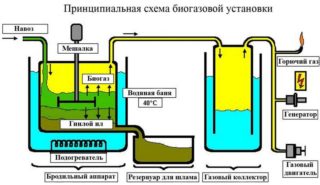 This device may have a different configuration, which depends on its power, the type of raw materials used and the product that results. Installation of a standard type includes the installation of a storage tank, mills and mixers, a gas holder for the accumulation of produced gas, a reactor and a system for supplying waste to it, fuel component transfer systems, processing, automation, control and protection of production processes. The biogas home station works according to the standard principle:
This device may have a different configuration, which depends on its power, the type of raw materials used and the product that results. Installation of a standard type includes the installation of a storage tank, mills and mixers, a gas holder for the accumulation of produced gas, a reactor and a system for supplying waste to it, fuel component transfer systems, processing, automation, control and protection of production processes. The biogas home station works according to the standard principle:
- Biomass is poured into an airtight container, which is diluted with water, where it begins to ferment and release a gas substance.
- The contents of the tank are updated by draining waste waste and adding fresh.
- The gas accumulated in the upper part of the tank passes through the tube to the gas collector and then to connected household appliances.
The main advantage of this alternative energy source is the reduction of methane emissions. After such processing and its phased process, effective fertilizers are formed, ideally suitable for fields and gardens, and also not containing hazardous impurities.
What raw materials are suitable for installation
Any biogas plant works best on a fresh organic component - livestock or poultry manure, which should be replenished every day. You can add chopped grass, tops or foliage to the reactor, including household waste, such as vegetable peeling. The effectiveness of the station depends on the type of raw materials used. The greatest amount of biological gas is obtained from a mixture of pig droppings and turkey manure. The combination of cow and silage waste allows you to get much less gas at a similar load.
Some factors can reduce the activity of anaerobic bacteria and even completely stop the production of natural biogas. Raw materials containing antibiotics, mold, detergent-type synthetic components and resins should not enter the tank. It is not necessary to use rotten manure; only fresh or dried waste can be loaded into the installation. In addition, the raw materials should not be waterlogged, a figure of 95% is considered critical.
In order to facilitate the loading of biological mass and accelerate the fermentation processes, it is necessary to add a little purified water to the waste and dilute it to a normal consistency.
The specifics of biogas production
Biogas produced at home is processed in a biological reactor over several stages. For some time, bacteria act on biomass, the exact timing of fermentation will depend on the volume of raw materials. Due to the work of bacteria, a combustible gas mixture is formed containing methane, carbon dioxide and a number of other substances, including hydrogen sulfide. Then the mixture passes from the reactor to the gas holder, where it is stored until the start of the intended use, the gas from there can also be used for servicing household appliances, its properties are not inferior to natural. The decomposed mass must be removed from the fermenter in a timely manner in order to ultimately receive high-quality fertilizer.
Calculation of the profitability of a biogas plant
Do-it-yourself biogas production is beneficial, since 1 cubic meter of this fuel provides the same amount of energy as 3.5 kg of firewood, 1-2 kg of coal or 9-10 kW of electricity. If you know the approximate weight of available waste and the amount of energy required, you can calculate the possible benefits and disadvantages of such a station.
An example is the calculation of a substrate prepared from 1.5 manure component, 3.5 tons of organic waste and heated water in an amount equal to 65-75% of the standard volume of organic matter. This raw material is designed for six months of moderate gas use. The fermentation process gives the desired result after 10-15 days, the gas will begin to be produced in a minimal amount and fill the tank. Thirty days later, the fuel will be fully developed. In the absence of problems and the correct operation of the station, the volume increases gradually until the substrate is completely rotted.
The productivity of a biogas plant will depend on the rate of raw material fermentation, which is associated with an increased level of humidity and substrate temperature.
DIY construction steps
Do-it-yourself biological gas is completely accessible to every owner of a private building, who can independently make the most simple and reliable installation. Its installation is carried out according to the drawings and consists of several steps.
Pit preparation
Since the biogas plant is located underground, the effectiveness of its operation will depend on how well the preparation and decoration of the special pit was carried out. Strengthen its walls with plastic, concrete or polymer rings, which must be equipped with a blank bottom. They will cost more than improvised materials, but they will not require additional sealant. Polymer components are not afraid of water and chemical components, but are sensitive to mechanical stress, if necessary, they can always be replaced.
Gas exhaust system
Obtaining natural biogas is carried out using a pipe, which is installed in the upper element of the barrel. The substance enters the water trap through a connected tube, then passes into the drive and moves to household appliances.Not far from the gas outlet, a trigger valve is installed, in case of excess pressure inside the tank, it will release excess substances.
Feed and unload system
To constantly produce a gas mixture in a biogas generator, bacteria inside the substrate must be constantly provided with fresh manure and organic matter. Waste raw materials are removed from the hopper so that it does not take up unnecessary space. Holes are made in the barrel for the purpose of unloading and loading, into which pipes with a diameter of at least 300 mm are welded. The loading-type pipeline should be directed upward, supplemented with a funnel, and the drainage part should be constructed in such a way that it is convenient to collect waste after processing during operation.
Heating system
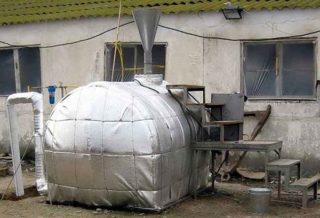
If the station is placed in the yard or in an unheated room, it will need to provide optimal thermal insulation and stable heating. For this purpose, you can bring into the installation of the tube along which water moves from the heating system, and install them along the walls of the barrel. Also, a tank filled with water heated by electric heating elements is placed in the reactor; the first option is considered more economical. For the installation to be stable, the temperature of its contents should not fall below 38 and rise above 55 degrees.
Mixing system
An additional hand mixer with any design can significantly increase the efficiency of the station. To create it, the axis with the blades welded to it is brought out through the barrel lid. Then they put on the handle-gate and completely seal the hole.
Mounting the dome and pipes
At the final stage, you will need to make a gas tank with your own hands for the biogas station and install the dome of its upper element. At the highest dome point, a gas exhaust pipe is placed and pulled towards the gas holder.
The free space inside the reactor functions as a gas storage, but this is not enough for the completely safe operation of the installation. To avoid explosion from high pressure under the dome, gas must be used continuously. To prevent the mixing of biological methane with air, a water trap is installed, which is also designed to purify the gas.
Advantages and disadvantages of a biogas plant
The list of benefits includes:
- the possibility of safe disposal of waste;
- obtaining renewable stocks of environmentally friendly raw materials;
- the release of a minimum amount of carbon dioxide and sulfur compared to conventional gas installations;
- full stability of the station;
- the ability to use several plants at once to reduce costs and prevent damage;
- maximum benefits for agriculture.
In addition to all these advantages, a biogas plant has its drawbacks. Such gas is relatively clean fuel, but it is still able to pollute the environment. Also, the owners of such stations may have difficulties with the supply of biomass, if they do not take care of this in advance.
